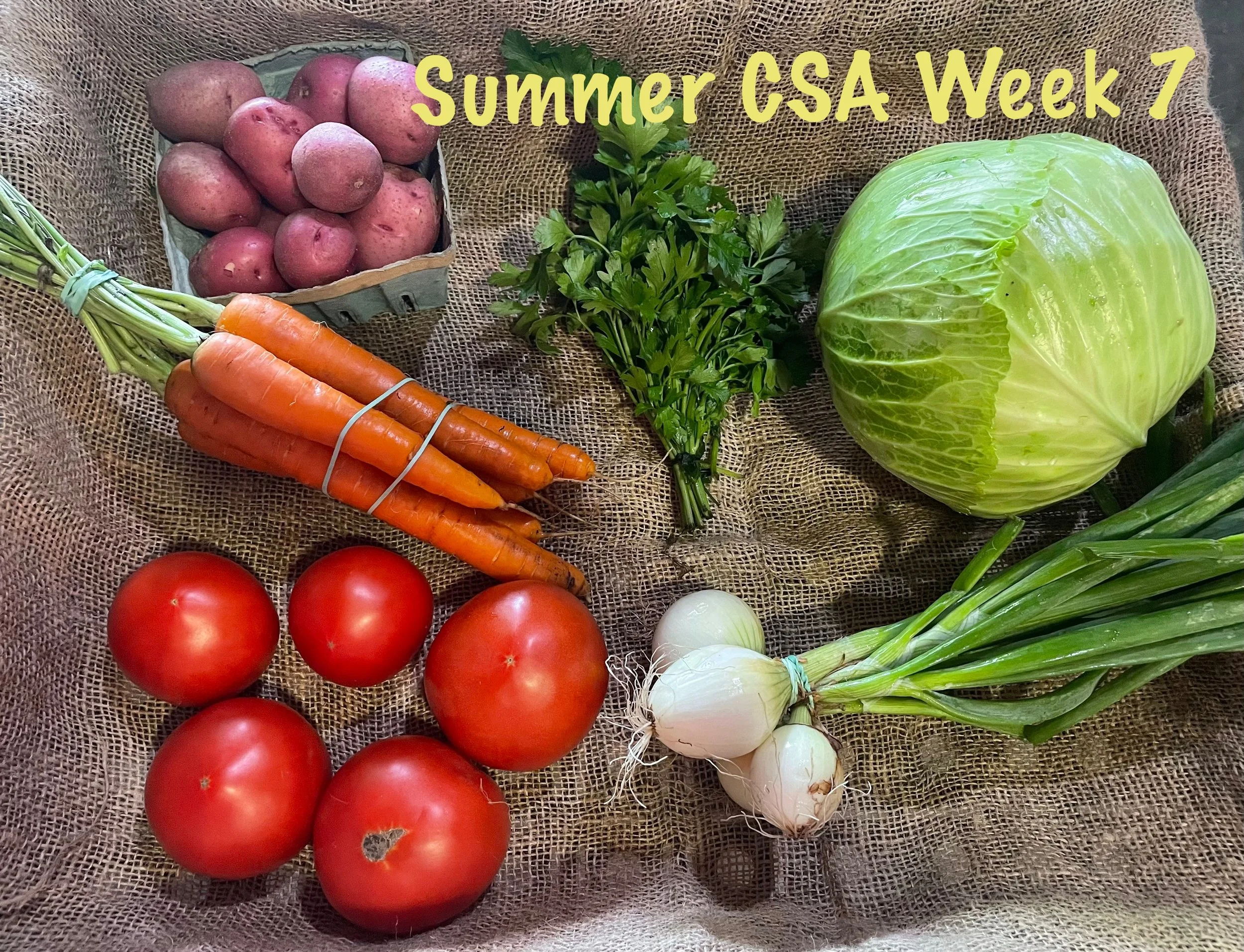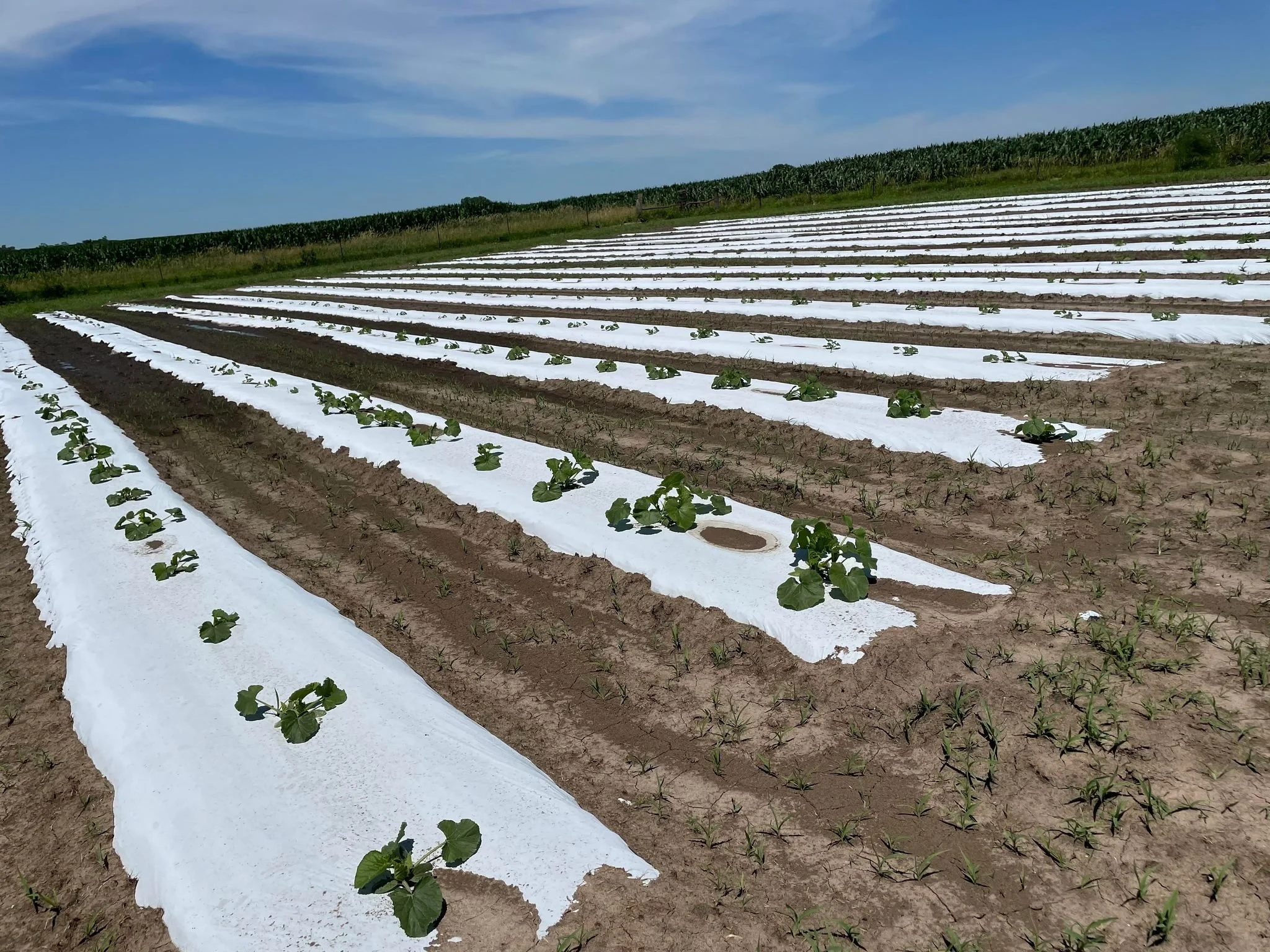Summer CSA Newsletter: Week 7
In your box this week and how to use it
CARROTS- If your carrots have the tops on, take them off right away to avoid limp carrots. The tops like to suck the moisture from the root (carrot) which makes for lifeless carrots. Store carrots in the refrigerator in a plastic bag or container. They can store for several weeks and sometimes even months. $5
SPRING ONIONS - Store in the refrigerator crisper drawer for up to one week. You can peel off layers that become dry or slimy if used after one week. $2.50
CABBAGE - Do not wash your cabbage until you are ready to use it. Place your cabbage in the crisper drawer and/or in a large plastic storage bag to hold in its natural moisture. Don’t cut the cabbage until you are ready to use it, this will increase your storage life. Use your cabbage within a month although they could last up to two months when stored appropriately. $5
HERB - Parsley , trim a little off of the bottoms of the stems so that they can take in more water. Fill a jar or glass partially with water and set the parsley inside. An inch or two of the stems should be submerged. Cover the jar of herbs loosely with a plastic bag. Store in the refrigerator. Change the water when it becomes cloudy. $2.50
POTATOES - Keep in a cool, dry place away from light, like a dark corner of the kitchen or in a cabinet. Also keep well ventilated. Do not store in a plastic bag but you can store in a basket or paper bag. $5
TOMATOES- The best way to keep summer tomatoes fresh and full of flavor, store them on the kitchen counter at room temperature and turn them shoulders down. 60 to 65° is an ideal temperature for storing and we recommend placing your tomatoes out of direct sunlight. (2.5#)$10
VEGGIE OF THE WEEK
CABBAGE
I consider myself fortunate to have had the opportunity to get to know one of my great-grandmothers very well. She lived until I was in my late thirties, and she was sharp as a tack until the very end. I didn't ask her often enough about her life. She lived through numerous major historical events and occasionally I would ask questions about her time living during the depression or her Polish parents that emigrated here. Her parents emigrated from Poland to Canada, with each of them arriving individually through a program where they paid off their passage and expenses gradually after their arrival. Despite both coming from the same village and possibly knowing each other, they only began their relationship after moving to Canada. Eventually, they relocated to the Detroit, Michigan area, but job opportunities became scarce. Just before or at the onset of the Great Depression, my great-great-grandfather purchased land in west Michigan and relocated his wife and children there. They took up farming to support the family, with my great-great-grandmother preparing many traditional Polish meals to feed everyone.
The one meal that was prepared regularly for us growing up and still continues to show-up is Galumpkis. Most people know them as cabbage rolls, but for us they have always been called by the Polish name of Galumpkis. Galumpkis are cabbage leaves stuffed with a mixture of ground meat, spices and rice that are baked in a tomato sauce. Healthy and delicious!
Photo Credit: Family Table Treasures
How my grandmother made her Galumpkis:
1 head of cabbage
1 pound Ground beef
3/4 Cup precooked long grain rice
1/4 Cup ,chopped fresh flat leaf parsley
1 teaspoon Salt
1 teaspoon Pepper
1 can of tomato soup
water
Fill a large stock pot with water and bring to a boil. Add whole head of cabbage and simmer until leaves begin to loosen and can be easily removed from head. (Once outer leaves are removed you may need to leave cabbage in a bit longer to loosen the leaves that were covered)
Once leaves are removed and cool enough to handle remove the hard vein from center of each cabbage leaf. (I only do this on the really large veins)
In a large mixing bowl mix, mix ground beef with rice, parsley, salt and pepper.
Spoon about 1/4 cup of meat mixture onto the center of a cabbage leaf and roll over once then tuck sides of the leaf in and continue to roll up to encase the meat mixture.
In a bowl mix the tomato soup and a can of water together. Put 1/4 - 1/2 cup of the mixture into the bottom of a casserole pan. then place the galumpkis with the seem side down into the dish.
Continue until you use all of your meat mixture. You may not use all of the cabbage leaves depending how big the head of cabbage is.
Pour tomato mixture over cabbage rolls and season with salt and pepper
Cover casserole with foil and place in oven for 30-40 minutes.
Remove foil and serve. I like to scoop as much as the tomato sauce on top of the galumpkis when serving.
Have fun experimenting and let us know how it turns out!
A couple other recipes to try this week:
Kiebasa and Cabbage. Another family favorite!
Kielbasa sausage: Look for this smoked sausage in the deli meats section of the grocery store.
Green cabbage: Green cabbage turns buttery and crisp-tender when sautéed!
Butter or bacon grease: Melt the unsalted butter or bacon grease and brown the kielbasa on both sides..
salt and pepper
Slice the kielbasa and chop the cabbage. Core and chop 1/2 head of green cabbage into rough 1-inch pieces.
Brown the kielbasa. Cook until browned, 6 to 8 minutes. Remove and set aside
Add the cabbage. Cook until tender and lightly browned, stirring occasionally and scraping the bottom of the pan to release any browned bits.
Add the kielbasa back to the cabbage. Salt and pepper to taste. Serve and enjoy!
Egg Roll in a Bowl Recipe - NatashasKitchen.com - great for using carrots, cabbage and onions in your box this week!
WEEK 7
The long summer days are coming on strong and filled with never-ending tasks on the farm, our bodies start to slow down, and we have a tendency to lose our fresh from rest vigor. It feels like all the energy we stored up during winter and the excitement of spring has been sucked right out of us. The weeds are growing rapidly as the temperature continues to rise. Matt and I I are working tirelessly to ensure the farm runs smoothly, while we also have to juggle taking care of maintaining the yard, cooking in the kitchen, and keeping up with the laundry. With 4 kids still at home and two farmers who sweat daily, the laundry is ridiculous.
Our two year old “assiting” in planting.
Silage tarp used to “cook” weeds before we plant again.
We are currently nearing the one-third mark of the season, and it seems to be a recurring pattern at this time every year. This feeling usually lingers for approximately four to six weeks until we hit the end of our summer CSA and take a week vacation with our kids in early August. There is another wave of energy that hits once the kids return to school and the countdown to fall happens. A renewal to our excitement as we push those last plantings and start to prepare for the change of seasons again. We love farming, but it and mother nature can be fickle beasts.
Thankfully up to this point the rain has been relatively frequent and in the amounts that are needed. Our back gardens are planted and have germinated well and fingers crossed we are on our way to a plentiful fall crop.
iF ALL ELSE FAILS
If your week has been crazy and you haven’t had time to do a thing with items in your bag, focus on these tasks:
Make sure the greens are removed from the root vegetables. Your roots will store for a good while, your greens from your root vegetables need to be used or lose them.
You can freeze green onions including the leafy green tops, the white bulb end, and the stem in between. After freezing, the texture changes somewhat. Stem and bulb portions become soft, while the green parts sometimes become tough
Rosemary can freeze. Wash sprigs thoroughly and dry them well. Leave the leaves on the stem and arrange the sprigs on a baking tray so that the individual stems do not touch − this prevents the stems from freezing together and makes it easier to remove individual sprigs later. Place the baking tray in the freezer for a few hours to freeze the rosemary sprigs. Once frozen, transfer the rosemary sprigs to a freezer bag and store them in the freezer. Frozen rosemary can be stored for a year or more. Frozen rosemary sprigs do not need to be defrosted before cooking
Oregano must be used quickly. Whether it's homegrown or purchased, oregano should be stored in a plastic bag in the refrigerator for up to three days. If you place a slightly damp paper towel in the bag with the oregano and leave some air in the bag, it may extend the life up to one week. You may also extend the shelf life of fresh oregano by storing whole stems with leaves in a glass of water with a plastic bag loosely tented over the glass. Fresh oregano can also be frozen. Before doing so, though, wash and dry the fresh oregano sprigs. Strip whole leaves from stems and place in plastic bag loosely without crushing but remove all air.
Parsley wash and dry thoroughly. You want to make sure no excess water is present as that can cause freezer burn. Cut the lower part of the stems. Place cleaned and dried parsley in a large freezer bag and push it down to the bottom.
With any herb you can also make a compound butter and freeze. Try this link for recipes: Herb Compound Butter Recipe - Love and Lemons or this one: Herb Compound Butter - Downshiftology
Freezing tomatoes is the easiest way to keep ripe tomatoes until you're ready to use them. You don't have to peel them first—in fact, the act of freezing them itself makes the tomatoes very easy to peel and you can freeze as many or as few at a time as you like. Visit this link for directions on how to do this, How to Preserve Tomatoes to Enjoy All Year
Greens such as carrot tops or other veggie scraps can be saved and used for homemade vegetable broth. Try this recipe: How to Make Vegetable Broth Using Saved Kitchen Scraps ~ Homestead and Chill
NEXT WEEK’S POSSIBILITY’S
Your bag next week will include 6-7 of the following depending on availability and if it’s ready to harvest.
Carrots
Herbs
Green Onions
Tomatoes
Fresh large candy onions
Green Tomatoes
Cherry Tomatoes (big maybe)
Kale/Swiss
Mixed Lettuce (maybe)
Cucumber
Cabbage
Fairytale Eggplant
Potatoes
Onions
Wishing you a fantastic week ahead, see you next week!







